Saturdays, noon to 1 p.m. ET on WICR 88.7 FM.
Or listen live from anywhere on WICR
Online!
Saturdays, noon to 1 p.m. ET on WICR 88.7 FM.
Or listen live from anywhere on WICR
Online!
Oct. 25 show
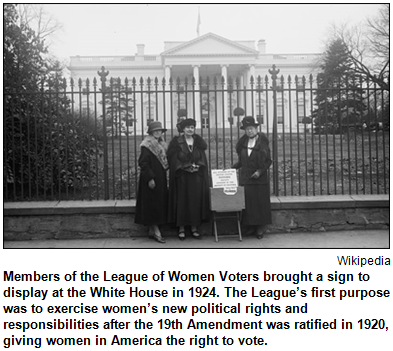 As Election Day approaches, Hoosier History Live will explore the heritage and community impact of the nonpartisan League of Women Voters - as well as the cultural and civic impact of two other historic women's groups that are more than 100 years old.
As Election Day approaches, Hoosier History Live will explore the heritage and community impact of the nonpartisan League of Women Voters - as well as the cultural and civic impact of two other historic women's groups that are more than 100 years old.
The Indianapolis Woman's Club was founded clear back in 1875, so it will turn 140 in February.
And the Woman's Department Club of Indianapolis celebrated its centennial in 2012; its heritage is intertwined with the Hoosier Salon and what became the Visiting Nurses Association in Indianapolis, among other well-known organizations.
All three women's groups pre-date November 1920, when women finally got to vote in a presidential election for the first time. (Both the Indiana and Indianapolis chapters of the League of Women Voters were founded several months earlier that year.)
 To explore the deep heritage of the three groups and how they have evolved, Nelson will be joined in studio by three guests:
To explore the deep heritage of the three groups and how they have evolved, Nelson will be joined in studio by three guests:
Members of the Woman's Club are expected to research and present papers; their topics cover a vast range, from arts and culture to science and education, but not religion or politics.
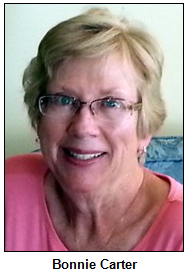 Although the League of Women Voters does not endorse candidates, it studies various issues and then forms policy positions. Topics range from immigration to, on the local level, redistricting reform.
Although the League of Women Voters does not endorse candidates, it studies various issues and then forms policy positions. Topics range from immigration to, on the local level, redistricting reform.
The name of the Woman's Department Club derives partially because, in 1912, "departments" were set up to provide activities and community outreach. They included an "art department," "music department" and an "education department."
A charter member of the club was appointed to the Indianapolis School Board.
According to info supplied by Bonnie, the first women's club in the country may have been a group organized in the historic village of New Harmony in southwestern Indiana.
A collection of treasured paintings, many done by the renowned Hoosier Group of artists in the early 1900s, hung in a former clubhouse owned by the Woman's Department. The clubhouse, on North Meridian Street, was sold in 1964. Then the paintings were housed at the Indianapolis Museum of Art before being sold at auction in 2001.
Proceeds from that sale of artwork (which included paintings by T.C. Steele and William Forsyth) were used to create a fund for scholarships in education and in endeavors supporting the arts. Among various outreach activities, the Woman's Department funds scholarships in nursing and sponsors awards for artists.
Today, the Woman's Department meets at the historic Indianapolis Propylaeum in the Old Northside neighborhood. So does the Woman's Club, whose founders in 1875 included educator May Wright Sewall, a dynamic civic leader who became an internationally known suffragist and an ally of Susan B. Anthony.
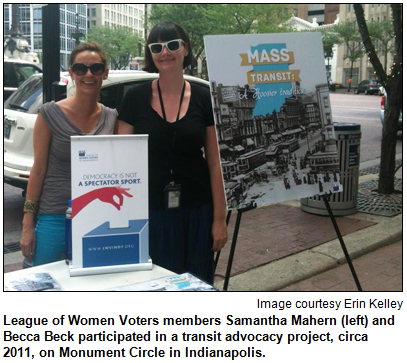 May Wright Sewall (1844-1920) also founded the Propylaeum. Her life and impact were the focus of a Hoosier History Live show in March 2012 with historian Ray Boomhower and Jan Wahls, a member of the Propylaeum Historic Foundation.
May Wright Sewall (1844-1920) also founded the Propylaeum. Her life and impact were the focus of a Hoosier History Live show in March 2012 with historian Ray Boomhower and Jan Wahls, a member of the Propylaeum Historic Foundation.
According to our guest Erin Kelley, the League of Women Voters is "a direct offshoot of the National American Suffrage Association."
About the time women won the right to vote in 1920, suffragist Carrie Chapman Catt and others, as Erin puts it, "saw the need to keep all these mighty women organized."
The League of Women Voters was envisioned to help them - and future generations of women - become informed, active citizens.
Some history facts:
Learn more:
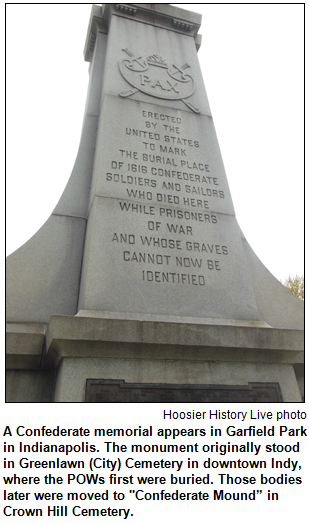 Guest Roadtripper William Selm, historian and adjunct faculty member at IUPUI, tells us to look around Indianapolis for hometown reminders of the Civil War.
Guest Roadtripper William Selm, historian and adjunct faculty member at IUPUI, tells us to look around Indianapolis for hometown reminders of the Civil War.
"We are in the midst of the American Civil War Sesquicentennial," he says, "and 150 years ago the war was still raging in its fourth year. Indiana was thick in the fight under the leadership of the war governor, Oliver P. Morton. This titanic conflict in American history is remembered throughout Indianapolis, and the most obvious reminder is the beloved Indiana Soldiers' and Sailors' Monument in the very center of the city."
Indianapolis also was the site of a prisoner-of-war internment camp. Camp Morton was opened in April 1861 as a training recruitment camp for Indiana volunteers. It was located in what had formerly been the Indiana State Fairgrounds before the fairgrounds relocated to 38th Street.
Camp Morton has an official cast-metal marker at North Alabama and 19th streets near where the camp entrance was. The prison camp's Col. Richard Owen, known to be kindly and humane, was remembered and honored by his former charges by a bronze bust that is near the center of the Indiana Statehouse.
The grimmer side of Camp Morton is remembered by the large granite Confederate Memorial in Garfield Park, just inside the southeastern entrance. It originally stood as the funerary monument in Greenlawn Cemetery, where the Confederate soldiers who died in captivity in Indianapolis were originally buried. The monument lists all the names of the Confederate soldiers, as well as their state regiments. A number came from border states that officially remained in the Union.
Other reminders include three Abraham Lincoln monuments, the Oliver P. Morton monument at the east entrance of the State House, the Camp Sullivan marker in Military Park and many others. The most recent reminder is the Indy Eleven Football (soccer) Club, named for Gen. Lew Wallace's (Brookville-born) 11th Indiana Regiment.
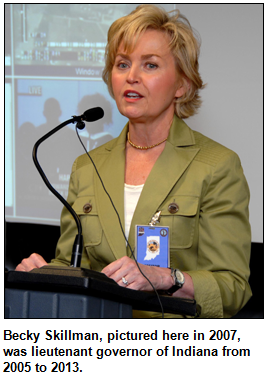 Bedford native Becky Skillman served two terms as Indiana's lieutenant governor after winning election in 2004 on the Republican ticket with Mitch Daniels. Although she became the first woman elected to the state's No. 2 post, Becky Skillman was not the first to serve in the office. In an earlier state administration, a woman was appointed to be Indiana's lieutenant governor when an opening occurred.
Bedford native Becky Skillman served two terms as Indiana's lieutenant governor after winning election in 2004 on the Republican ticket with Mitch Daniels. Although she became the first woman elected to the state's No. 2 post, Becky Skillman was not the first to serve in the office. In an earlier state administration, a woman was appointed to be Indiana's lieutenant governor when an opening occurred.
Question: Name the first woman to serve as the state's lieutenant governor.
Hint: Her stint in the office occurred during the last 15 years.
The call-in number is (317) 788-3314. Please do not try to answer the question until you have heard Nelson pose the question on the air, and please do not try to win if you have won another prize from WICR in the last two months.
The prize pack includes a gift certificate to the Mikado restaurant and two passes to the IMAX Theater at White River State Park, courtesy of Visit Indy, and a pair of passes to GlowGolf at Circle Centre mall, courtesy of GlowGolf.
Your Hoosier History Live! team,
Nelson Price, host and
creative director
Molly Head, producer, (317)
927-9101
Richard Sullivan, webmaster
and tech director
Pam Fraizer, graphic
designer
Garry Chilluffo, media+development director
Please tell our sponsors that you appreciate their support: Indiana Authors Award | Indiana Historical Society | Lucas Oil | Story Inn | The Fountain Square Theatre Building

 Acknowledgments to Monomedia, Visit Indy, WICR-FM, Fraizer Designs, Heritage Photo & Research Services, Derrick Lowhorn and many other individuals and organizations. We are an independently produced program and are self-supporting through organizational sponsorships and individual contributions. We do not receive any government funding. Visit our website to learn how you can support us financially. Also, see our Twitter feed and our Facebook page for regular updates.
Acknowledgments to Monomedia, Visit Indy, WICR-FM, Fraizer Designs, Heritage Photo & Research Services, Derrick Lowhorn and many other individuals and organizations. We are an independently produced program and are self-supporting through organizational sponsorships and individual contributions. We do not receive any government funding. Visit our website to learn how you can support us financially. Also, see our Twitter feed and our Facebook page for regular updates.
Nov. 1 - encore presentation
Only two states, Ohio and Pennsylvania, have larger Amish populations than Indiana.
The 49,000 Amish here live in about 22 distinct communities scattered across the state, from Elkhart and LaGrange counties in northern Indiana to settlements near the towns of Washington in southern Indiana, as well as Berne and Geneva in the northeast.
 In this encore broadcast of one of the most popular shows in our Hoosier History Live archives (its original air date was Oct. 5, 2013), Nelson's guest is Steve Nolt, a history professor at Goshen College and co-author of a book that poses these questions:
In this encore broadcast of one of the most popular shows in our Hoosier History Live archives (its original air date was Oct. 5, 2013), Nelson's guest is Steve Nolt, a history professor at Goshen College and co-author of a book that poses these questions:
"What is it about the Amish that both enchants and perplexes us? ... Could a horse-and-buggy people be more satisfied than the rest of us, with all our modern conveniences?"
Steve is the co-author of The Amish (Johns Hopkins University Press, 2013), which explores all aspects of the "intensely private and insular" folks known, as his book puts it, "for their simple clothing, plain lifestyle and limited technology."
During the show, Steve and Nelson explore the ever-increasing population of Amish in Indiana (the average family has seven children) as well as their values, schools and their shift from an almost exclusive focus on farming to jobs in factories and businesses. Employers include the RV industry in the Elkhart area - even though the Amish do not own or drive motor vehicles.
In addition to being the co-author of The Amish, Steve Nolt is the author or co-author of several other books about the Amish and has collaborated on multiyear projects about their religion, history and distinctive culture.
© 2014 Hoosier History Live! All rights reserved.
Hoosier History Live!
P.O. Box 44393
Indianapolis, IN 46244
(317) 927-9101